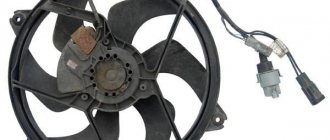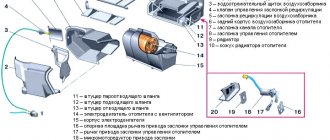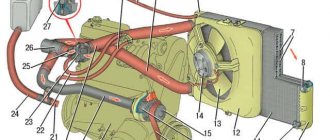There are many important components in a car, and the quality of the car as a whole depends on how well they work. One of these is the cooling system. It often happens on some models that the cooling fan is constantly running. This is not a very good sign. Insufficient engine cooling can lead to overheating of the engine - and this, in turn, can cost the owner a large sum of money for major repairs. But if you know the reasons for such operation in the cooling system, you can quickly identify where the fault is hidden and eliminate it. In order to find a breakdown, you do not need special knowledge and skills. Even a beginner can handle this. There are not many reasons why the cooling fan is constantly running.
The principle of operation of a fan in a cooling system
One of the reasons why a fan may run constantly or turn on frequently is due to the way the system operates. The fan starts at the command of a special sensor. It is located on the bottom of the radiator. This sensor is responsible for the coolant temperature indicators. If it is larger than needed, then the radiator fan will start.
When its blades rotate, additional airflow is created. It helps reduce the temperature of the coolant, which then passes through the passages in the engine. The cooling fan constantly works only on motors that for some reason overheat. To avoid serious problems, it is necessary to respond to this problem immediately.
Why is the cooling fan constantly running?
If the engine fan runs constantly, there may be 7 reasons for this.
Coolant temperature sensor
- Failure of the coolant temperature sensor or damage to its wiring . If incorrect information is sent from the sensor to the ECU (high or low signal, its absence, short circuit), then errors are generated in the ECU, as a result of which the control unit puts the engine into emergency mode, in which the fan “threshes” constantly to prevent overheating engine. You can tell that this is the problem by the difficulty of starting the engine when it is not yet warmed up.
- Shorting the wires to ground . Often the fan runs constantly if its negative wire is frayed. Depending on the engine design, this may be in different places. If the design of the engine provides for two DTOZH, then if the “minus” of the first sensor breaks, the fan will “thresh” when the ignition is on. If the insulation of the wires of the second DTOZH is damaged, the fan runs constantly when the engine is running.
- Faulty fan relay . For most cars, the fan power supply consists of “plus” from the relay and “minus” from the ECU according to the temperature from the DTOZH. “Plus” is supplied constantly, and “minus” is supplied when the antifreeze operating temperature is reached.
- "Glitches" of the electronic control unit . In turn, incorrect operation of the ECU can be caused by a failure in its software (for example, after flashing) or when moisture gets inside its housing. The moisture could be banal antifreeze that got into the ECU (relevant for Chevrolet Cruze cars, when antifreeze gets into the ECU through a torn throttle valve heating tube, it is located near the ECU).
- Dirty radiator . This applies to both the main radiator and the air conditioner radiator. In this case, the fan often runs constantly when the air conditioner is on.
- Freon pressure sensor in the air conditioner . If it fails and if there is a refrigerant leak, the system “sees” that the radiator is overheating and tries to cool it using a constantly turned on fan. Some car enthusiasts have a cooling fan that constantly runs when the air conditioner is turned on. In fact, this should not be the case, since it indicates either a clogged (dirty) radiator or a problem with the freon pressure sensor (freon leak).
- Low efficiency of the cooling system . Failures may be associated with a low coolant level, a coolant leak, a faulty thermostat, a pump failure, or a depressurized radiator cap or expansion tank. With this problem, the fan may not work constantly, but for a long time or turn on frequently.
Thermostat
The engine may overheat due to the thermostat. It often happens that the mechanism of this element jams. The fan, in turn, necessarily reacts to this. The thermostat itself remains only half open.
As a result, the coolant cannot effectively remove heat from the engine as its movement through the system slows down. When the power unit overheats and the coolant temperature rises, the sensor reacts to this event and starts the fan. Owners of Opel Astra cars often encounter this problem - the cooling fan is constantly running. And the problem is solved by replacing the thermostat.
How to check the cooling system thermostat
Testing it is quite simple. To do this, you need to start the engine and warm it up to such temperatures when the valves of this mechanism operate. You can find out the temperature threshold directly on the device body. Usually it is 72 or 80 degrees. Then you need to check the temperature at the lower and upper pipes. If both are at approximately the same temperature, then the reason why the cooling fan is constantly running has been found. It is recommended to carefully inspect the thermostat valves after removing it. It is useless to repair this unit (it is easier and cheaper to buy a new one). By the way, if this element is dismantled, it can be checked without installing it in the car. To do this, the thermostat is placed in a container of water, which is then heated. Increasingly, the valve should open. If this does not happen, the device is faulty.
Cooling pump
Sometimes the reason why the cooling fan keeps running and won't turn off is the water pump. The temperature of the coolant in the radiator rises because its speed is slowed down. When liquid enters the cooling radiator, the antifreeze simply does not have time to cool to the required temperatures and passes to the next round. At the same time, the liquid heats up even more.
When the pump works somehow, the fan may indicate a problem. If the pump completely breaks down, then the engine will immediately boil - this is where serious problems and expensive repairs usually begin.
water pump
In many cases, the reason for the increase in coolant temperature in the radiator is poor operation of the water pump. In this case, the antifreeze moves slowly through the system and heats up too much. Once it gets into the radiator, it does not have time to cool down to normal temperature, and goes around the next circle, heating up even more. If the pump at least works, then this problem is expressed only by the constant operation of the fan. If the pump fails completely, then the car will “boil” in a matter of minutes. This is an extremely dangerous condition that almost always leaves consequences in the form of engine problems.
Usually the water pump does not suddenly fail. First, it gives signals about its malfunction. The first warning sign is an increase in the frequency of operation of the radiator fan. The main cause of failure is destruction and jamming of the bearing. Therefore, a manifestation of a breakdown may be a howling noise from under the hood or a knocking sound that is clearly audible when idling. Often a knocking sound from the pump is mistaken for a camshaft fault. The breakdown is eliminated by replacing the pump; in some models it is possible to replace only the front part of the pump along with the bearing.
Pump faults
Often, the pump does not stop working suddenly. Initially, the pump gives various signals about breakdowns - for example, the engine cooling fan is constantly running or turns on frequently.
The main reason for pump failure is the bearing - it jams or collapses. You can tell that the pump has failed by the characteristic sounds coming from under the hood. They sound like some kind of howling or knocking. These sounds can be heard even at idle. Novice motorists often do not pay attention to these noises. Pump knocks are mistaken for camshaft malfunctions. To fix the problem, you need to replace the pump. Depending on the model, it is possible to install only the front part of the pump and replace the bearing.
Clogged cooling system channels
Often the engine overheats due to congestion in the cooling system. The situation is further complicated by the fact that diagnosing this problem can be quite difficult. Therefore, if the cooling fan constantly works or turns on more often than usual, it would not be superfluous to flush the SOD channels. In most cases, these activities are more than enough to ensure everything works correctly. Experts also recommend not limiting yourself to just flushing, but also additionally venting the radiator.
How to clean the cooling system
When cleaning the channels of the cooling system and radiator, the antifreeze is also replaced. To perform flushing, the old antifreeze must be drained. Then a fairly strong solution based on citric acid is poured into the system. This is an effective folk remedy, but there are also various liquids with additives.
After this, start the engine - so the car should run for 30 minutes. This is enough to thoroughly clean all channels. Then you can turn off the engine, drain the cleaning mixture, and finally add fresh antifreeze. Often in this way it is possible to completely solve problems in the operation of the cooling system if the reasons are contamination.
VAZ 2107 fan sensor malfunctions and performance check
It is easy to find out whether the VAZ 2107 fan switch sensor is working properly. The fan motor is quite noisy; you can hear it turning on even from inside the cabin. If the temperature gauge shows more than 90 degrees, but the fan does not turn on, you should check the sensor.
First you need to localize the source of the problem. If the antifreeze is hotter than 90 degrees, but the bottom of the radiator remains cold, the problem is the thermostat, not the fan. It is not possible to replace the thermostat on the road. To get out of the situation, you can increase the cooling by fully opening the heater damper and turning on its fan. Of course, such a solution will be extremely uncomfortable in the warm season, but, if you’re lucky, it will make it possible to get to the repair site without stopping. If this is not enough, you will have to make stops along the way to allow the engine to cool.
Another reason for overheating is low coolant level. In this case, it is necessary to quickly find and eliminate the leak and add antifreeze to the system. If it is not there, you can add water to the system. But then, as soon as possible, it is necessary to drain the liquid from the cooling system and add antifreeze.
If the radiator is hot and the fan does not start, you need to try to start the fan by short-circuiting the two wires going to the sensor contacts. If the cause of the breakdown is the latter, the fan should start working.
If the sensor is not installed on the car, you can check it using a thermometer and ohmmeter. You need to place the part of the sensor that is inserted into the radiator into water and heat it to about 90 degrees. The sensor should turn on when the water heats up to no more than 92 degrees. The switching on (closure of the sensor contacts) is indicated by the absence of resistance between the sensor terminals.
How to flush a radiator
To correct the situation and protect the motor from harmful overheating, it is recommended to clean the element. On most modern cars, the part must first be dismantled, but cleaning can often be done without dismantling.
Experts recommend cleaning with ordinary water. It is best if it is supplied through a hose. Sometimes it makes sense to clean the radiator cells with a brush and only then flush them. Often this procedure is combined with blowing the radiator with compressed air.
Air locks in the cooling system
For experienced car owners, air locks are not a secret at all. They arise due to some errors during the process of replacing the coolant. Leaks in the system are also the cause. Antifreeze cannot warm up evenly. This leads to instability in the fan operation. It often turns on or even works without interruption - hot coolant enters the radiator. Before you try to eliminate these same traffic jams, you need to check the system for leaks. If they are found, then they should be eliminated. Next you need to remove the plugs. For this you need a compressor. One tube is unscrewed from the throttle, which supplies fluid. Then a compressor is connected to the neck of the expansion tank and the air supply begins. Two to three minutes will be enough for all traffic jams to go away.
Electric cooling fan operation
The design of the “classic” cooling system does not provide for constant fan operation. It should turn on only after reaching a certain coolant temperature, we discussed this in more detail in this article. The fan switching sensor for the VAZ 2107 injector is installed in the radiator. Therefore, the fan turns on after the radiator itself can no longer cope with the cooling task. This is implemented as follows:
- After heating the antifreeze in the “small circle” of cooling, the thermostat opens.
- The coolant circulates in a “large circle” through the radiator, which ensures effective heat exchange with the environment.
- If the radiator does not “cope” with cooling, the contacts of the fan sensor close and it begins to intensively drive air flow through the radiator, increasing heat transfer.
If the sensor fails, the fan turns on when it overheats and the coolant may boil.
Problems with the temperature sensor
If the cooling fan on a VAZ 2107 is constantly running, then the radiator temperature sensor on both carburetor and injection cars is often to blame. In most cases, it is simply in a closed state.
If these are the symptoms, then check the time for which the fan turns on and compare the temperature when it turns on with the standard one. If the indicators are lower, then the problem is easily solved by replacing the sensor.
Broken DTOZh wiring
It is known that on a VAZ 2114 the cooling fan often runs constantly due to a faulty coolant temperature sensor. But sometimes it is not he himself who is to blame, but his wiring. It can be torn or closed for various reasons. This can be determined by testing the wires with a multimeter. You can often see a break during a visual inspection. Restoring the integrity of the wiring will help solve this problem with the fan.
Summarize
So, among the most popular reasons why a fan is unstable are problems with electronics. This is exactly what most car owners complain about on specialized forums. Many solve this problem by replacing the sensor and fuses. And it helps. In half of the cases, the issue can be resolved by replacing the thermostat. The situation can also be improved by cleaning the radiator.
Problems happen on any car; this topic worries Ford Focus car owners. The cooling fan runs constantly on luxury cars as well. It is important to notice this problem in time, otherwise it can lead to disastrous consequences. In case of severe overheating, the engine can only be helped by a major overhaul with the replacement of the cylinder head, cylinders, pistons and other components.
Forced fan activation
If the VAZ 2107 fan sensor is broken, it is quite possible to drive on a good road without noticing it. But as soon as you drive onto a country road or get into city traffic jams, the engine will start to overheat. Replacing the fan sensor is not very difficult, but requires draining the coolant. Even if you have a spare sensor at hand, replacing it on the road is problematic. There is an easier way out of the situation.
The following operations must be performed:
- disconnect “mass”;
- remove two wires from the sensor terminals and connect (“short-circuit”) them;
- insulate the exposed contacts of the connected wires;
- connect ground.
In this case, the fan will run continuously. To turn it off, you will have to disconnect the ground and disconnect the contacts.
If you have already experienced problems with the fan sensor on the road, you can install a forced fan circuit on the car that operates in parallel with the sensor. To do this, just connect a couple of wires to the terminals going to the sensor contacts and stretch them into the engine compartment. Install a separate button (toggle switch) on the dashboard and connect the wires to it so that you can close them if necessary.
In this case, if the sensor malfunctions, there will be no need to crawl under the hood to force the fan to start.










